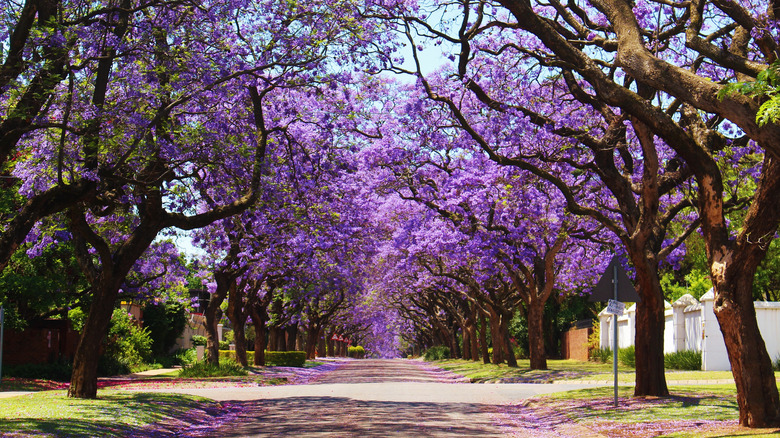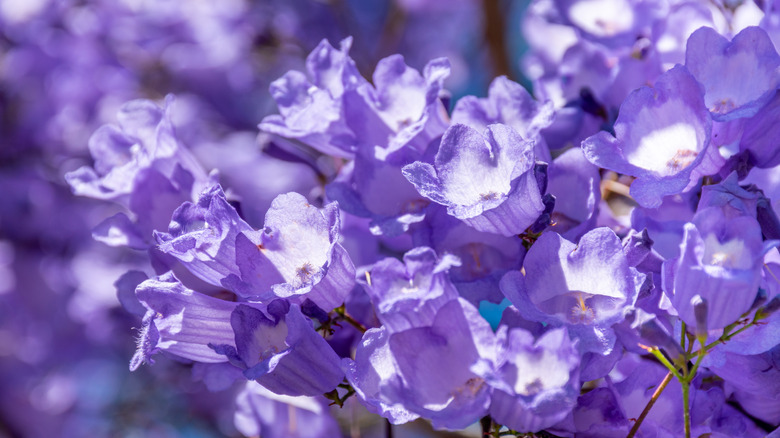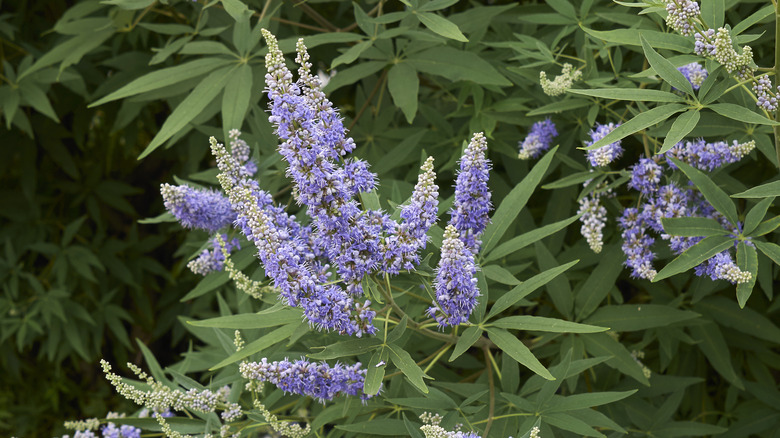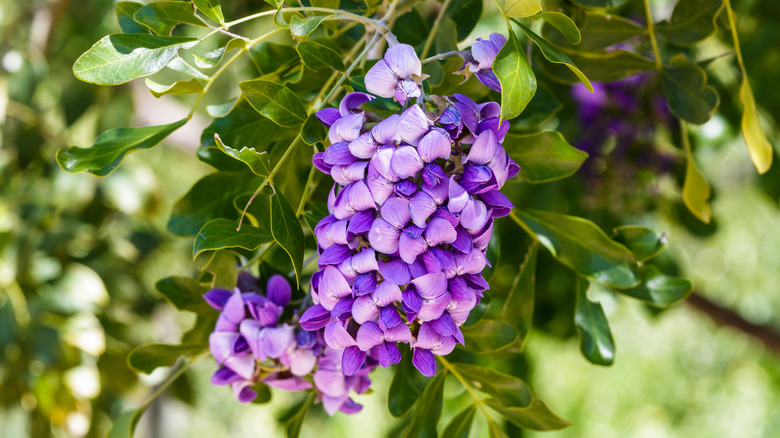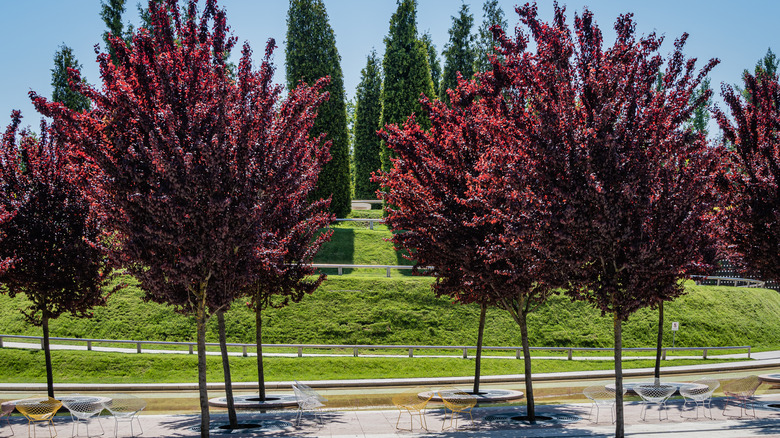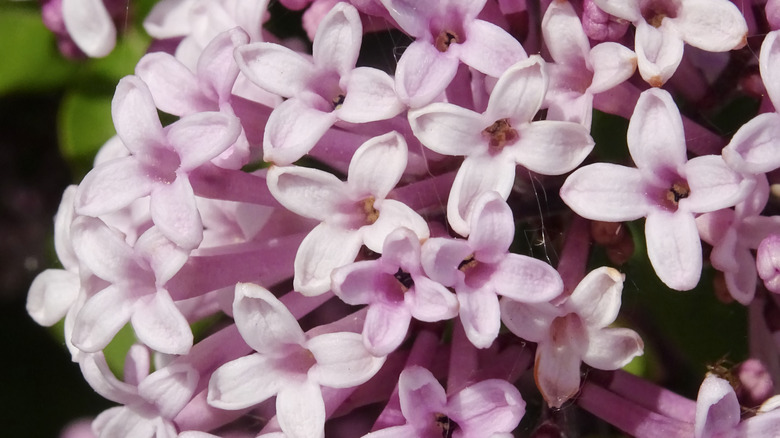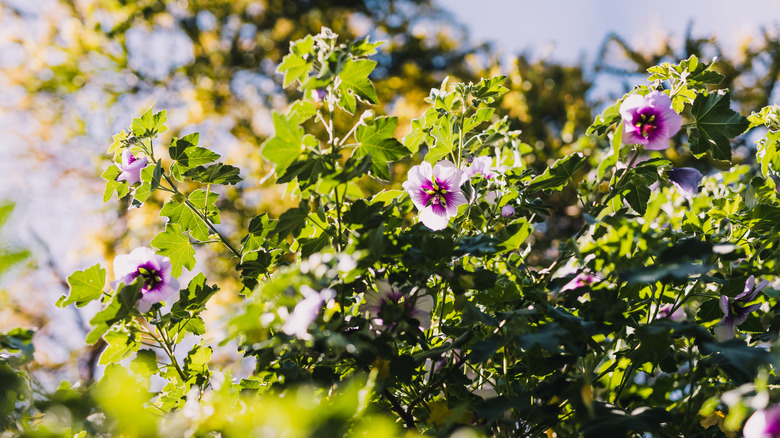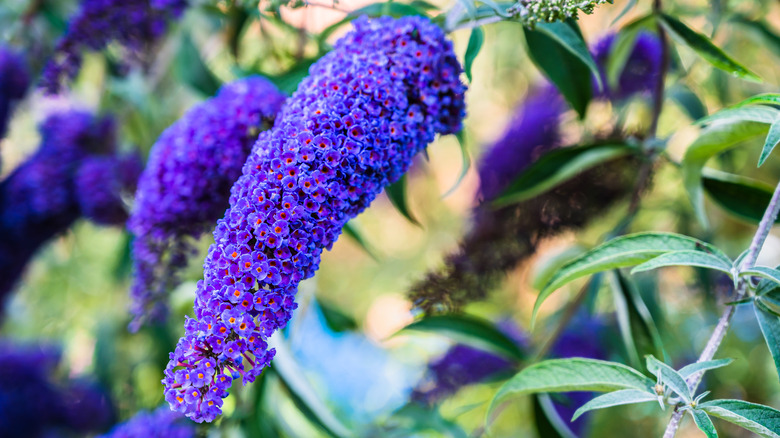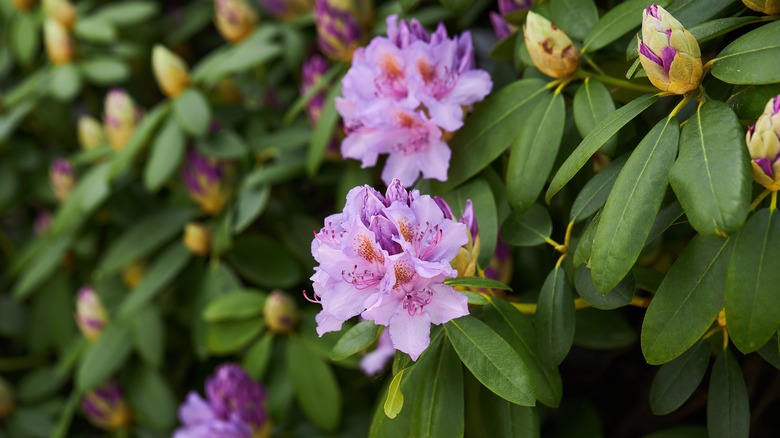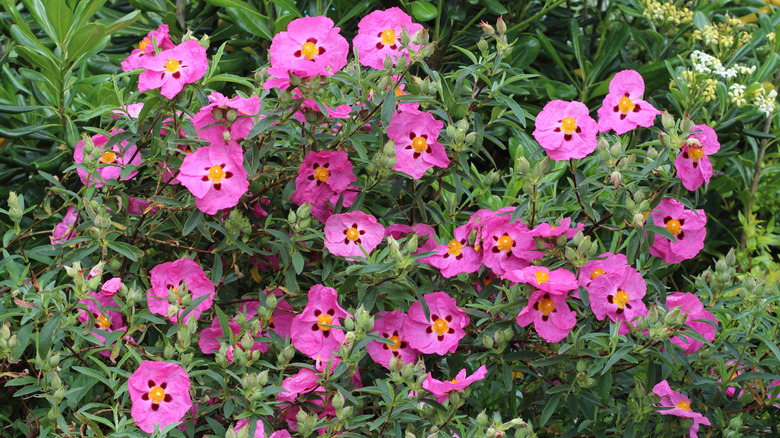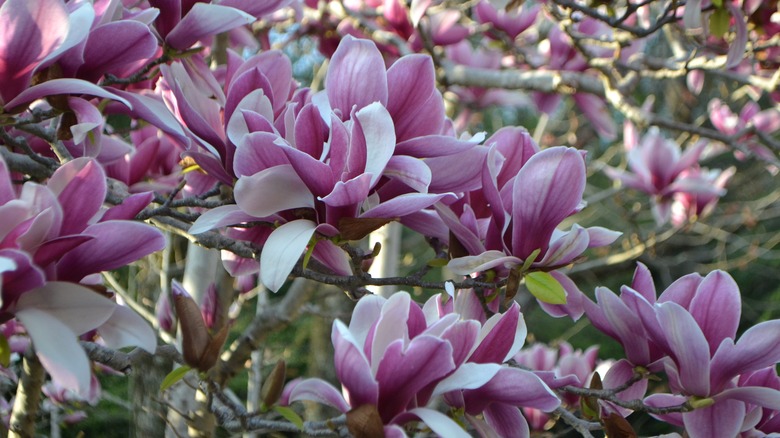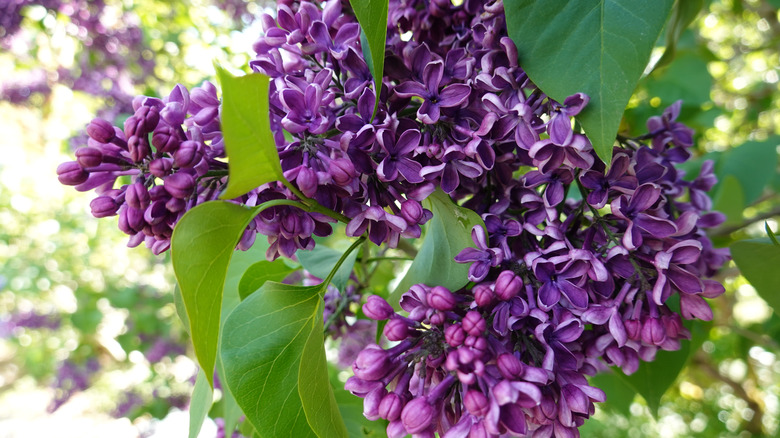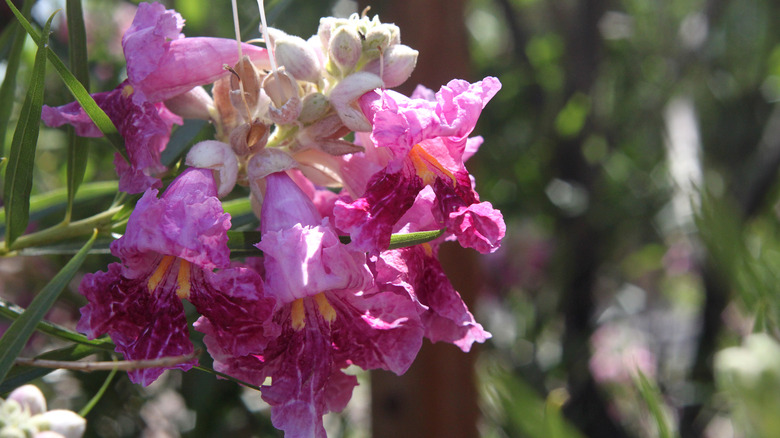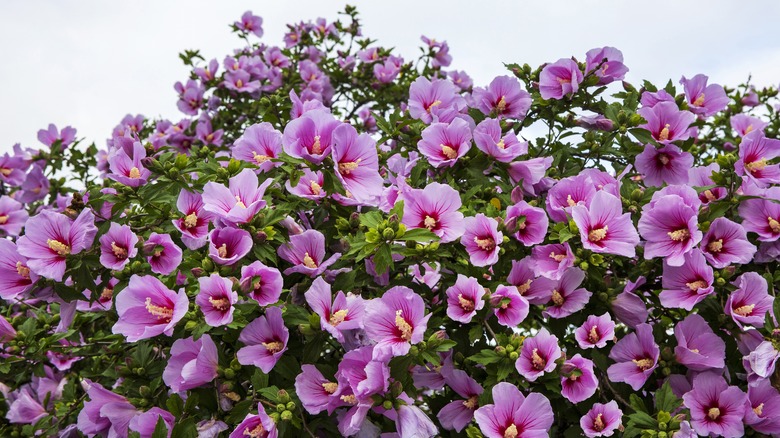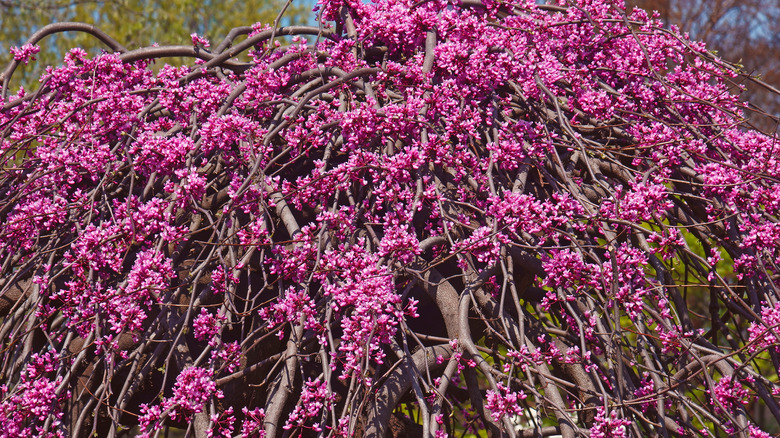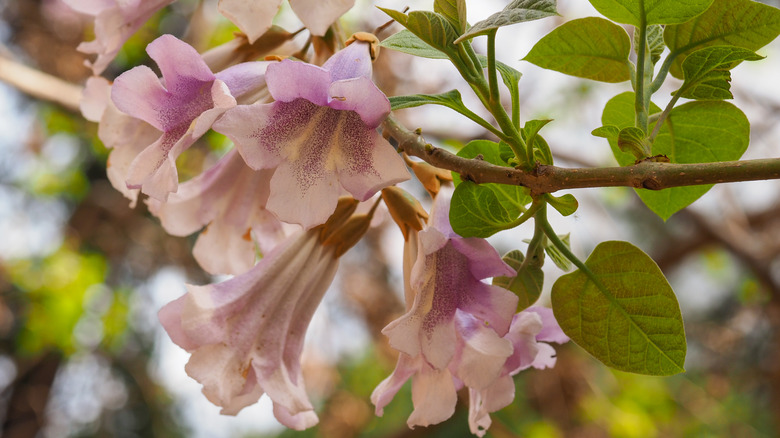15 Trees That Bloom With Gorgeous Purple Flowers
If you have a big enough backyard, why not add a beautiful touch of color? If you've already done that by creating a garden bed, that's great! But why not go the extra step and plant a flowering tree? Not only will it add more height and interest to your yard, but you can place a bench underneath and relax under the shade, or use it as a focal point to determine how to design the rest of your space.
If this is something you're interested in, you may want to particularly plant trees with purple flowers, as they're very beautiful and some love sitting in the heat — which is especially useful if you plan to plant one during the summer, per Moon Valley Nurseries. So if you're a fan of violet, lavender, and other purple shades, take a look at the plethora of tree options you have to choose from.
Jacaranda
Jacaranda (Jacaranda mimosaifolia) is a beautiful tree that sprouts lavender flowers with a blue tinge (via IFAS Extension). This tree emits a soft smell, and its flowers tend to bloom from April to August — with the most blooms typically appearing in May.
It's a tree that prefers porous soil, and is capable of growing 25 to 40 feet high, with an equal width. It's native to southern and central South America, and the USDA hardiness zones 9b-11.
Chaste tree
Chaste tree (Vitex agnus-castus) produces striking purple flowers that follow the stem up to create a cone shape, per the North Carolina Extension Gardener Plant Toolbox. Depending on how you prune the tree, it can grow anywhere from 8 to 20 feet high.
Not only is it pretty to look at, but it has a fragrance that attracts birds, butterflies, and bees; while also being resistant to deer. Chaste trees are hardy to zones 5-9 and like to be out in the full sunlight; you can expect the flowers to bloom during the spring and summer.
Texas mountain laurel
The Texas mountain laurel (Sophora secundiflora) has an average mature height of around 10 to 15 feet, per Lady Bird Johnson Wildflower Center. Just like its name implies, it's native to the state of Texas, as well as New Mexico.
It grows lavender-blue flowers that grow in clusters and softly droop while emitting a strong fragrance similar to grape bubble gum. The beautiful flowers are 3 to 7 inches big and bloom during February and March in hardiness zones 7b-11.
Purple leaf plum
The purple leaf plum (Prunus cerasifera 'Krauter Vesuvius') doesn't produce purple flowers, but instead dark purple leaves that are dramatic and sure to add contrast to your garden if you need it, per Boething Treeland Farms.
In the springtime, it produces pink flowers. But by September, the leaves will be a dark purple and perfect for the fall aesthetic. It's resistant to the cold and can grow 18 to 20 feet high in USDA zones 5-8. Make sure it's placed somewhere it can get direct sunlight, and it will need a moderate amount of water.
Dwarf Korean lilac
The dwarf Korean lilac (Syringa meyeri 'palibin') produces beautiful flowers that are a mixture of lilac and pink, per Gertens Garden Center. It can grow about 7 feet tall, with a spread that reaches 4 feet wide.
The flowers bloom in late spring out of violet buds, and are beautifully complemented by the dark green foliage the tree produces. It does well in both moist and dry areas, but does require to be out in the full sun. It's a hardy plant (zones 3-7, via Horticulture). If you take care of it well, it can live up to 30 years.
Lavender rose of Sharon Althea tree
The lavender rose of Sharon Althea (Hibiscus syriacus 'notwoodone') will provide you with beautiful lavender roses all summer long and into the fall, per Brighter Blooms. The tree grows up 6 to 8 feet, and creates a gorgeous display of dark green leaves with purple flowers popping out in random areas.
It's disease-resistant and attracts hummingbirds — which are great pollinators! It's a tree that's easy to take care of and does well in growing zones 5-9.
True blue butterfly bush
The true blue butterfly bush (Buddleia 'bostulu') can either be formed as a tree or bush and can grow up to 4 to 6 feet tall, per Fast Growing Trees. Its bluish-purple flowers are vibrant and bloom throughout spring, summer, and fall.
It has a fragrance that attracts butterflies and hummingbirds, and the flowers form into purple clusters with a red center. It loves being out in the full sun and typically thrives in growing zones 5-10.
Mountain laurel
Mountain laurel (Kalmia latifolia) produces flowers of many different colors, including purple, according to the North Carolina Extension Gardener Plant Toolbox. It has an average height of about 6 to 10 feet tall but can grow up to 30 feet tall (in USDA zones 5-9).
The flowers are beautiful and dainty and typically bloom from late spring to early summer. It also loves a variety of shade, but should be kept at a distance as it can be poisonous to humans and pets.
Orchid tree
The orchid tree (Bauhinia variegata) is native to China and India and produces large, purple, fragrant flowers, per the IFAS Center for Aquatic and Invasive Plants. The tree has the capability of growing an astonishing 50 feet tall with a wide crown.
Orchid trees tend to grow quickly and thrive in areas that are humid and hot (hardiness zone 9). The flowers bloom in the springtime and are formed with five petals that overlap each other.
Saucer magnolia
The saucer magnolia tree (Magnolia x soulangeana) can grow 33 feet high, and its spread tends to create a pyramid-like shape, according to the North Carolina Extension Gardener Plant Toolbox.
This tree comes in different colors, including a pinkish-purple color that blooms in the spring; its flower size is about 6 inches. A saucer magnolia likes moist, well-drained soil in areas where it can get partial to full sun exposure. It can grow in many zones (4-9) and produces a fragrance that's known to attract bees.
French lilac
The French lilac (Syringa vulgaris), or common lilac, produces beautiful purple flowers, as well as flowers of other colors, and emits a strong fragrance, per the University of Maryland Extension.
It's hardy to zones 4-8 (via My Garden Life) and can reach 8 to 16 feet in height with a spread of 6 to 12 feet wide. The flowers bloom in a lovely clump form in the springtime and attract all sorts of pollinators; it does this while also being resistant to deer.
Desert willow
The desert willow (Chilopsis linearis 'burgundy') produces beautiful, large, purple flowers from May to September and can grow 15 to 30 feet high, per Boething Treeland Farms. It prefers to sit in the full sun and only needs very little water occasionally (zones 7b-11).
The flowers are shaped like trumpets with yellow strokes found deeper into the flower toward the center. This can be a great border for your garden, and attracts birds and butterflies.
Rose of Sharon
The rose of Sharon (Hibiscus syriacus) produces a plethora of flower colors, including purple, according to Oregon State University. It can grow 8 to 12 feet tall and likes to stand in full sun to partial shade, as well as moist soil.
It also enjoys the hot weather (in USDA growing zone 5) but does not like extremely wet or dry conditions. The flowers on this tree tend to bloom from late spring until early fall, per the Arbor Day Foundation.
Lavender twist
Lavender twist (Cercis canadensis 'covey') is a unique tree with a twisted trunk and droopy branches covered in purple flowers, per Meadows Farms Nurseries & Landscape.
The tree grows up to 6 feet with an 8-foot spread, and its flowers bloom out in early to mid-spring. The flowers look as though they're tied in adorable bunches, and it also has beautiful heart-shaped leaves. This tree is known to grow slowly and can live for 40 years or more in zones 5-9.
Royal empress tree
The royal empress tree (Paulownia tomentosa) is a gorgeous, striking tree that produces light violet flowers. It can grow anywhere from 30 to 60 feet tall, per Oregon State University's Department of Horticulture.
Native to China, you can now find this tree in various parts of the U.S., from southern New York to Georgia. This tree also produces a lovely vanilla scent, and the flowers typically start blooming in early spring. The royal empress is hardy to zone 5, does well in full sun to partial shade, and isn't picky about soil conditions.
